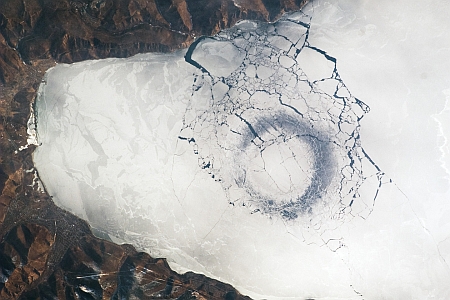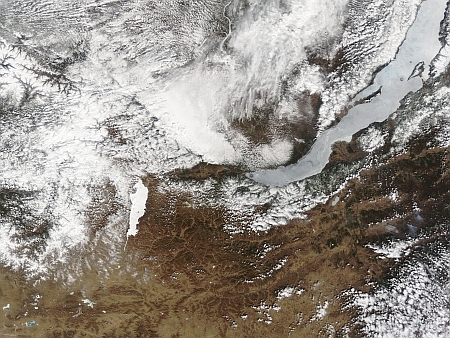Remote Sensing of Natural Heritage Sites
Lake Baikal, Russian Federation (2/2)
Contribution of Remote Sensing
Astronauts aboard the International Space Station observed in late April 2009 a strange circular area of thinned ice in the southern end of Lake Baikal. In this remote and cold region of the World the ice cover can persist until June.
The upper image shows a circle of thin ice (dark in colour, with a diameter of about 4.4 kilometers); this is the focal point for ice break up in the very southern end of the lake. A sequence of MODIS images indicates that the feature was first visible on April 5, 2009.
At the same time Lake Baikal contained another, very similar circle near the centre of the lake above a submarine ridge that bisects the lake (ice circles are indicated by arrows in the below MODIS image from April 20). Both circles are visible through April 20, 2009.
While the origin of the circles is unknown, the peculiar pattern suggests convection (upwelling) in the lake's water column. Ice cover changes rapidly at this time of year. Within a day, the ice can melt almost completely and freeze again overnight. Throughout the month of April, the circles were persistent: they appeared when ice cover formed, and then disappeared as ice melted. The pattern and appearance suggest that the ice is quite thin. The features were last observed in MODIS images on April 27, 2009.
What can cause convection, bringing warmer waters to the surface? Hydrothermal activity and high heat flow have been observed in other parts of the lake, but the location of this circle near the southern tip, over relatively deep water, is puzzling.
Experts interviewed by the LiveScience website in June said that this mystery can be explained by the action of methane gas rising from the lake floor.
Methane emissions can create a rising mass of warm water that begins swirling in a circular pattern because of the Coriolis force.
"Once the water mass reaches the underside of the ice on the surface of the lake, the warm water melts the ice in a ring shape," said Marianne Moore, a marine ecologist at Wellesley College in Massachusetts who has spent much time studying Lake Baikal with Russian researchers.
This phenomenon is nothing new to the Russian government, which has documented circle sightings on an official Ministry of Natural Resources Web site. The Russian Ministry of Natural Resources points out that random emissions of natural gas have probably always occurred in Lake Baikal. And such emissions would have created ice rings every few years.
"But, because of the huge size, it is practically impossible to see a ring standing on the ice or even from a mountain," the Ministry Web site notes. As a consequence, the Russian government has ordered daily space monitoring of the Lake Baikal area in recent years.


